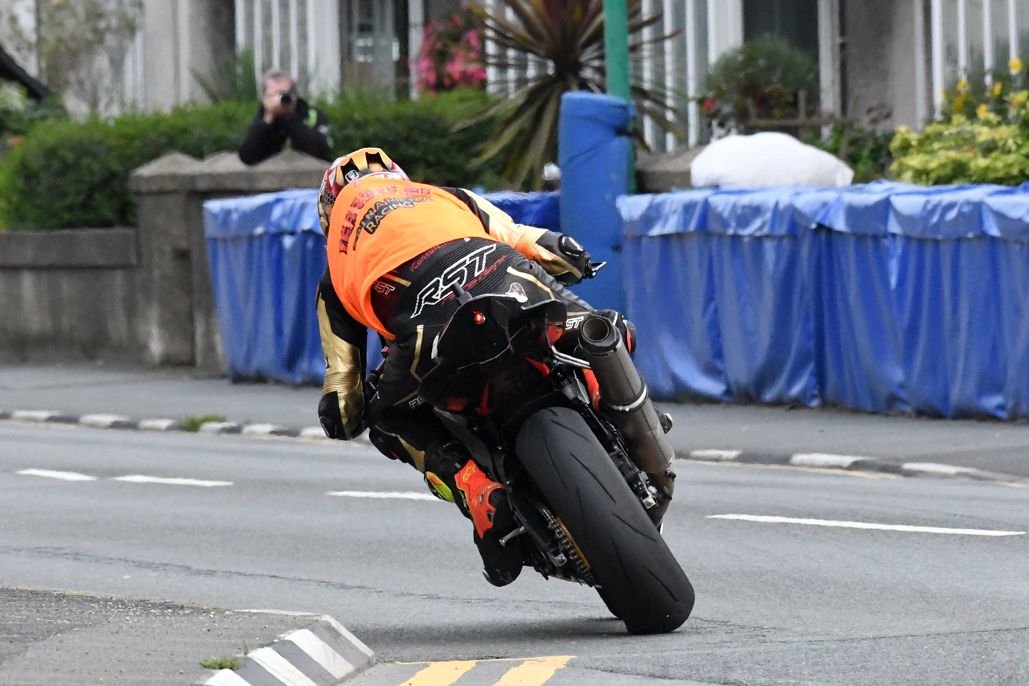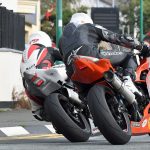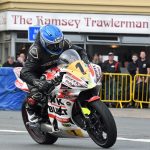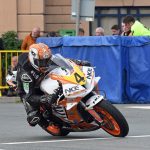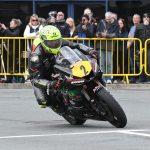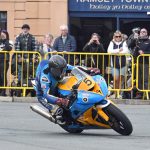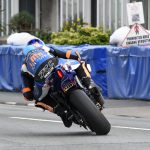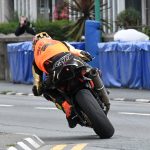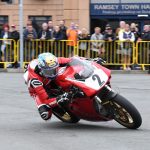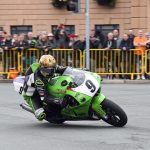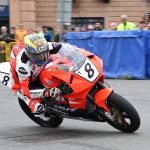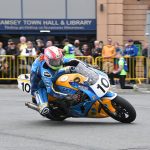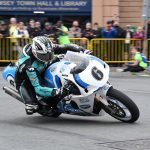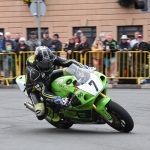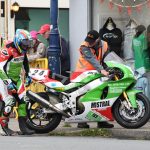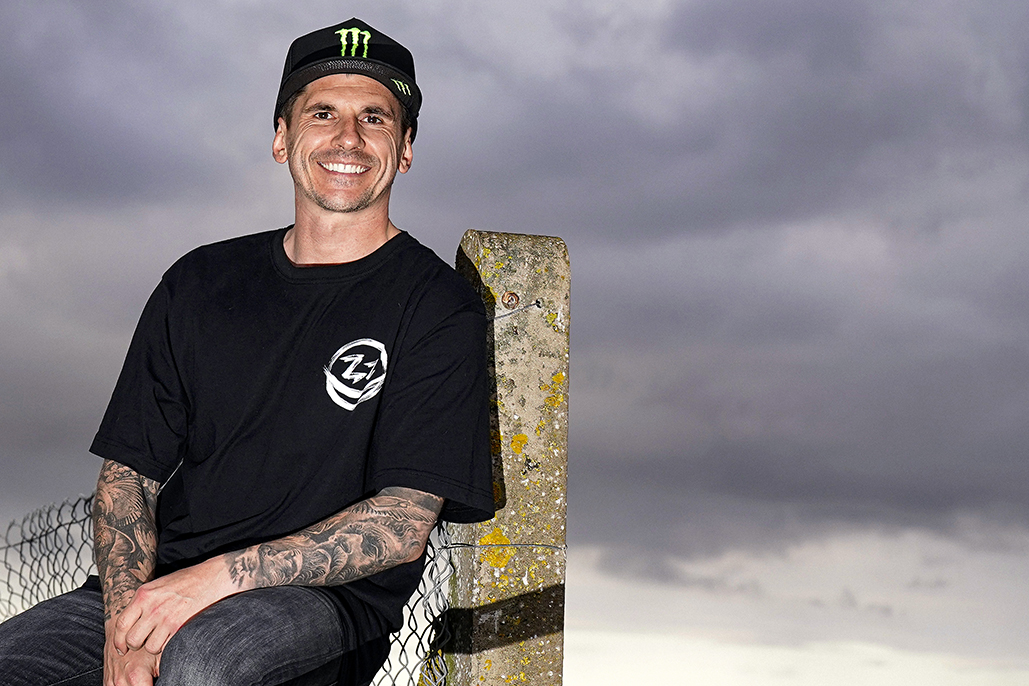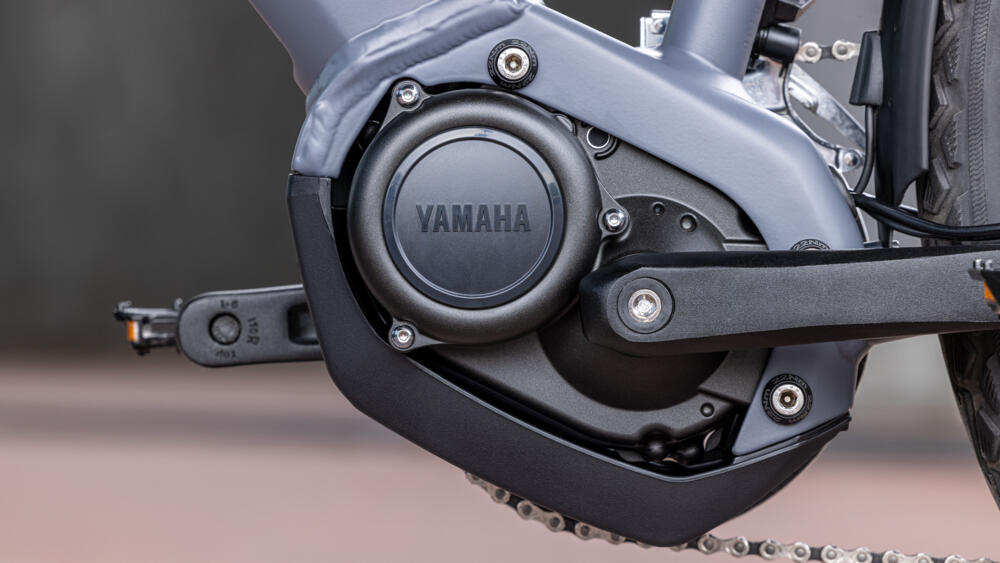Headlines
New stars shine brightly in Senior MGP, before Dunlop masterclass in Classic Superbike.
Headlines
The final day of the Manx Grand Prix was one of weather delays that caused the first race to be starting when the meeting should have been over. The time lost caused both of the day’s races to be cut from 4 laps to 3; but that did not detract from the races. The Senior saw two young Manx riders continue their rise rise to the top as they duelled for victory at record pace, despite the less than ideal conditions. Ultimately, Joe Yeardsley beat Marcus Simpson by 9.5s to take the winner’s laurels; this gave us the first Senior victory for a newcomer since 2012 when John Simpson won on his Triumph from fellow newcomer, the late Andy Soar. That race day was also dogged by poor weather.
At 4.30pm, Daniel Ingham (Brook Built Yamaha) received the tap on the shoulder, and racing that had seemed more than unlikely was underway. The damp patches were confined mainly to the section from Ballaugh to Ramsey; plus, the worst area of all Ramsey Hairpin to Waterworks. Fastest in practice, Marcus Simpson Atherstone Yamaha) had been moved up the order to take the vacant number 3 birth; whilst fellow 120mph newcomer Joe Yeardsley (Spin Arena Yamaha) was moved to 15 to take the birth vacated by Ben Rea.
The locals were fast to Glen Helen; the timing there showed that Joe Yeardsley led by 0.74s from Marcus Simpson, with Jamie Williams (NCE Honda) 1.59s further back in third. Daniel Ingham, Chris Cook (Cowan Kawasaki) and David Rigby (Gasiom Kawasaki); another of the talented group of local newcomers; completed the top 6. The order was the same at Ballaugh; with the lead just 0.3s. It was here that Maurico Bottalico; third in the Junior; retired from the race.
Ingham was first to break the silence at Ramsey; he was neat and fast through the square. Simpson was next; then Williams; with Junior winner Victor Lopez (ILR Yamaha) next but not quite on the pace of the leaders. Shortly after, the small crowd was treated to an intake of breath moment when Sam Mousley (Gwrhyd Yamaha) overtook James Reveley (PCN Yamaha) on the outside, going around the second corner; fortunately, Reveley was able to hold a tight line. Yeardsley had sighters around the track and had been told to be careful on the damp patches; he was also being careful how and where he passed slower riders. The timing beam at White Gates showed that Simpson was now the race leader, by 3.67s from Yeardsley; with Williams only 0.48s further behind. Ingham, Cook and Rigby filled out the top 6.
Simpson was the fastest man up the mountain; he led by 4.5s at the Bungalow; whilst Yeardsley had opened his advantage over Williams to 4s. A lap at 120.053mph gave Simpson a lead of 7.25s as he came into pitlane for the mandatory stop. Yeardsley and Williams both lapped at over 119mph; the gap being 1.93s. Ingham, Rigby and Cook completed the top 6. Tom Robinson (Pete Stacey) was a retirement at Quarter Bridge; he had been in 7th position. At Glen Helen, Simpson’s lead was 8.7s; marginally less than it had been at the pit lane exit. Williams remained third, he was 6.8s down on Yeardsley. Yeardsley was fastest to Ballaugh; the lead there was 7.94s
At Ramsey, Simpson led on the road by 100m from Ingham. Yeardsley was up to sixth on the road and like the others, neat, fast and bang on the ideal line. He was on a charge and had cut the deficit to 4.32s; whilst increasing his advantage over Williams to 12.58s. Yeardsley was marginally the fastest up the mountain; the lead for Simpson being 3.94s at the Bungalow. The two leaders were now taking chunks of time out of the others. Yeardsley continued to edge closer; Simpson’s lead was down to 2.55s as they started the final lap of the 37.73 miles of the Mountain Course. Williams was 25.s down on Yeardsley; but just 2.84s ahead of Ingham. Cook was 5th; with Lopez up to 6th following Rigby’s retirement.
At Glen Helen on the final lap, Yeardsley was on the pace to set a new 600cc lap record for the event. He was now back into the lead, by 2.13s from Simpson. Ingham was raising his pace; he had moved ahead of Williams by 1s. Another sector best for Yeardsley saw his advantage up to 3.82s as they went through Ballaugh; with just over half of the lap to go. Yeardsley was fastest to Ramsey, and led by 6.51s as they began the final mountain climb.
Yeardsley was fastest to the Bungalow and Cronk ny Mona and with his lap record of 122.051mph he took a superb victory by 9.545s from Simpson; whose performance was outstanding given that he had to miss his scheduled TT debut due to injury. Yeardsley’s story was also amazing; he did not have an engine for the bike in early July; leaving very little time to have it set up and race tested. Ingham won the dice for 3rd beating Williams by 6.27s. Chris Cook was 5th and Victor Lopez 6th. Local man Marc Colvin (CBG Contractors KTM) put in another fine ride to take 7th. Jack Fowler (MC Services Triumph), Andrew Fisher (Fisher Yamaha) and newcomer Eddy Ferre (Team Gazz 58 Yamaha) completed the top 10. This was a superb race with new talent rising to the top and it saw a young man equalling his father in winning the Senior Manx Grand Prix; Buddy Yeardsley having won in 1985 on an RG Suzuki.
There was definitely an autumnal air as the MGP Classic Superbike race began under darkening skies and with the temperature falling. 2019 winner Davo Johnson (Cowan Kawasaki) was the hare for the others to catch. He set off for Bray Hill at 18.40; three hours after the race should have been completed. As with the Senior MGP; it had been cut to 3 laps; with a mandatory pit stop at the end of lap 1. For Craig Neve the chance of a podium was lost before he left the line; the machine refused to fire for 45s. James Hillier fared little better; he only reached the top of Bray Hill. Mike Browne’s problems with his Kawasaki continued; it gave up the ghost at Union Mills.
At Glen Helen on the opening lap, Dean Harrison had the red, Key Racing, Ducati in the lead by 2.5s from the Team Classic Suzuki of Michael Dunlop. Third in practice, Davo Johnson was third in the race; 2.4s down on Dunlop. Brian McCormack (Greenall Kawasaki), last year’s winner Rob Hodson (Greenall Kawasaki) and Michael Rutter (Batham’s Suzuki) completed he top 6. Best Newcomer at this year’s TT; Ryan Cringle (Mistral Kawasaki) was going well in 7th; just ahead of the returning Nathan Harrison on the Ashcroft RC54. Harrison’s lead was unchanged at Ballaugh Bridge.
Davo Johnson was first to reach Ramsey; Harrison was second on the lovely looking and sounding Ducati; he had taken 7s out of the starting interval from Johnson. The riders put on a good show for the hardy spectators scattered around the square. Dunlop was quickest on the run into the northern capital; he had snipped the lead down to 1.9s as they set off to face the mountain section for the first time. Johnson was 5.8s down on Dunlop. Hodson, McCormack and Rutter completed the top 6. Dunlop claimed another 0.5s on the mountain climb. He had cut the lead to just 0.5s at Cronk ny Mona; where he was considering the option of retiring a bike that after the race he described as being; to paraphrase; in a sub-optimal condition for the job. It sounded fine and looked stable on the bumps at the exit to Parliament Square.
Entering the pits for the mandatory stop; Harrison’s lap at 124.767mph gave him 0.5s advantage. Davo Johnson was third 9.7s down on Dunlop. Hodson, McCormack and Rutter completed the top 6. Rutter was soon to lose that position; going along Quarterbridge Road a tear off was sucked into the carburettors and kept the engine going at full revs when the throttle was rolled back. Michael managed to stop the machine and resolve the problem; but the time lost dropped him out of the top 30. Dunlop was 2s faster than Harrison in the pits and was the new leader at Glen Helen, by 0.1s. Rutter’s misfortune had allowed Paul Jordan (Mistral Kawasaki) to take 6th.
Dunlop was the fastest man on track to Ballaugh and again to Ramsey; his lead was 6.62s as he left to climb the mountain. The only change here was that Derek Shiels (Greenall Kawasaki) had displaced Jordan from 6th. Michael was fastest to the Bungalow; with his advantage 11.7s. For Harrison, the race was over 400m up the road from the Bungalow; the Ducati expired at Brandywell. At the start of the final lap Dunlop led by 33.96s from Johnson. Hodson was third; just 3s down on Johnson. McCormack, Shiels and Jordan completed the top 6.
With a commanding lead, Dunlop could have eased off; but he did not; he went at what was hailed as being lap record pace. His pace was faster than last year’s fastest ever Manx Grand Prix Classic Superbike lap set by Nathan Harrison; but not as fast as the record pace set by Bruce Anstey on the Padgett Yamaha when the race was titled the Classic TT Superbike; confused; so is everyone else. Michael was stretching away, and the main interest centred on the battle for second in which Johnson’s advantage over Hodson was down to 1.98s at Ballaugh; nearly halfway around the course. At Ramsey, the advantage for Johnson was just 0.9s. There was frantic activity in Parliament Square as the black flag was prepared for Ryan Cringle (9th at Ballaugh). He was stopped; the rear silencer bracket had sheared; his race was over. Well done to whomever noticed that.
Dunlop continued at his record breaking pace; whilst Johnson and Hodson remained less than 1s apart on the mountain climb. Johnson had received the message and with two fastest sector times he secured second place by 2.105s. Dunlop’s final lap at 126.681mph gave him a margin of victory of 43.692s and made up for his disappointments in 2019 and 2022 when he retired whilst leading. Brian McCormack took a fine 4th place; Nathan Harrison snatched fifth by 1.13s from Craig Neve, who rode superbly to salvage a top 6 finish from his disastrous start. Paul Jordan, Derek Shiels; Shaun Anderson; on the rotary Wiz Norton that was smoking through Ramsey on the last lap; and Almaric Blanc (Eden Expo Kawasaki) completed the top 10.
The fact that racing took place at all was a vindication of the decisions taken by Gary Thompson. The loss of the warmup lap was a minor inconvenience; this lap is a recent innovation. Sending a couple of riders out to assess the fitness of the course for racing was also a wise move. There is little doubt that there would not have been sufficient marshals or medics to allow racing on the following day. He communicated his decisions and reasoning well; something appreciated by the trackside viewers.

